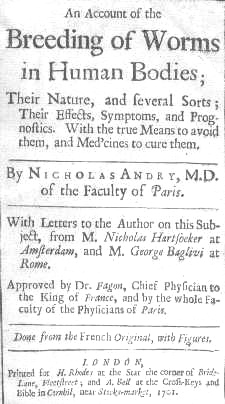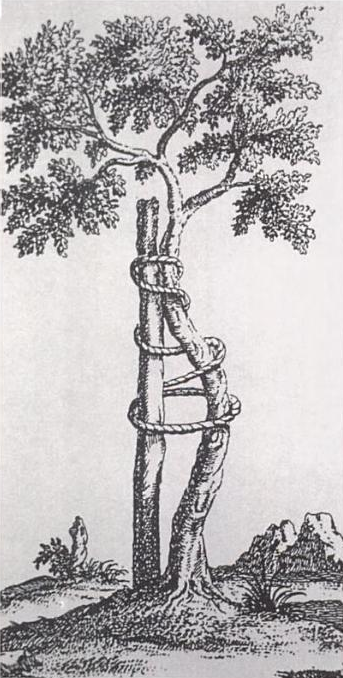Nicolas Andry on:
[Wikipedia]
[Google]
[Amazon]
 Nicolas Andry de Bois-Regard (1658 – 13 May 1742) was a French physician and writer. He played a significant role in the early history of both
Nicolas Andry de Bois-Regard (1658 – 13 May 1742) was a French physician and writer. He played a significant role in the early history of both
 Andry's early medical work lies within the nascent
Andry's early medical work lies within the nascent  The book contains a detailed discussion of
The book contains a detailed discussion of
 Though the book was read and cited extensively in the period, its main lasting influence in medicine has been its title, which became the name of the field devoted to skeletal and related injuries and ailments (later modified to "orthopædics" and "orthopaedics" or, in American spelling, "orthopedics").J. B. Kirkup,
Though the book was read and cited extensively in the period, its main lasting influence in medicine has been its title, which became the name of the field devoted to skeletal and related injuries and ailments (later modified to "orthopædics" and "orthopaedics" or, in American spelling, "orthopedics").J. B. Kirkup,
Nicolas Andry and 250 years of orthopaedy
" ''The Journal of Bone and Joint Surgery'', vol. 73-B, no. 2 (1991), 361–362. Outside of medicine, the principal impact of the book derives from the engraving on the frontispiece, which shows a straight stake tied to a crooked
 Nicolas Andry de Bois-Regard (1658 – 13 May 1742) was a French physician and writer. He played a significant role in the early history of both
Nicolas Andry de Bois-Regard (1658 – 13 May 1742) was a French physician and writer. He played a significant role in the early history of both parasitology
Parasitology is the study of parasites, their host (biology), hosts, and the relationship between them. As a List of biology disciplines, biological discipline, the scope of parasitology is not determined by the organism or environment in questio ...
and orthopedics, the name for which is taken from Andry's book ''Orthopédie''.
Early life and career
Andry was born inLyon
Lyon,, ; Occitan: ''Lion'', hist. ''Lionés'' also spelled in English as Lyons, is the third-largest city and second-largest metropolitan area of France. It is located at the confluence of the rivers Rhône and Saône, to the northwest of ...
, and spent his early life preparing for the priesthood. His early studies were widespread, however, and he published a book on the usage of the French language
French ( or ) is a Romance language of the Indo-European family. It descended from the Vulgar Latin of the Roman Empire, as did all Romance languages. French evolved from Gallo-Romance, the Latin spoken in Gaul, and more specifically in N ...
in 1692.
In his 30s he studied medicine at Reims
Reims ( , , ; also spelled Rheims in English) is the most populous city in the French department of Marne, and the 12th most populous city in France. The city lies northeast of Paris on the Vesle river, a tributary of the Aisne.
Founded b ...
and Paris
Paris () is the capital and most populous city of France, with an estimated population of 2,165,423 residents in 2019 in an area of more than 105 km² (41 sq mi), making it the 30th most densely populated city in the world in 2020. Si ...
, receiving his degree in 1697, and in 1701 he was appointed to the faculty of the Collège de France and the editorial board of the ''Journal des savants
A journal, from the Old French ''journal'' (meaning "daily"), may refer to:
*Bullet journal, a method of personal organization
* Diary, a record of what happened over the course of a day or other period
*Daybook, also known as a general journal, ...
''.
Worms
 Andry's early medical work lies within the nascent
Andry's early medical work lies within the nascent germ theory of disease
The germ theory of disease is the currently accepted scientific theory for many diseases. It states that microorganisms known as pathogens or "germs" can lead to disease. These small organisms, too small to be seen without magnification, invade ...
. His first book, ''De la génération des vers dans les corps de l'homme'', was published in 1700, and translated into English in 1701 as ''An Account of the Breeding of Worms in Human Bodies''. The book was an account of Andry's experiments with the microscope
A microscope () is a laboratory instrument used to examine objects that are too small to be seen by the naked eye. Microscopy is the science of investigating small objects and structures using a microscope. Microscopic means being invisi ...
, building on the earlier work of Antonie van Leeuwenhoek
Antonie Philips van Leeuwenhoek ( ; ; 24 October 1632 – 26 August 1723) was a Dutch microbiologist and microscopist in the Golden Age of Dutch science and technology. A largely self-taught man in science, he is commonly known as " the ...
, whom Andry cites frequently. Unlike Leeuwenhoek, Andry's purpose is specifically medical, and his experiments with the microscope led him to believe that the microorganisms he called "worms" were responsible for smallpox
Smallpox was an infectious disease caused by variola virus (often called smallpox virus) which belongs to the genus Orthopoxvirus. The last naturally occurring case was diagnosed in October 1977, and the World Health Organization (WHO) c ...
and other diseases.
 The book contains a detailed discussion of
The book contains a detailed discussion of spermatozoa
A spermatozoon (; also spelled spermatozoön; ; ) is a motile sperm cell, or moving form of the haploid cell that is the male gamete. A spermatozoon joins an ovum to form a zygote. (A zygote is a single cell, with a complete set of chromos ...
, which Andry calls "spermatic worms." He observes: "If you cut up a dog, and after you have taken off one Testicle, by the help of a Microscope examine the Humour that comes out of the deferent vessel, you shall discover in it such a hideous number of little worms, that you shall hardly be able to believe your own Eyes." Andry confirms an argument previously made by Leeuwenhoek, that spermatozoa are "the occasion of the Generation of all Animals." Though Andry recognizes the importance of sperm to reproduction, however, he addresses their workings primarily in the context of parasitology, and essentially considers spermatozoa to be a unique species of parasitic worm.
The book seems to address a general audience in addition to a medical one. As medical historian Clara Pinto Correia has observed, one of Andry's principal purposes was to educate the public about the new science that was emerging from under the microscope. He wrote, "We must admit that there are animals a thousand times less than a grain of dust, which we can scarcely see. ..Our imagination loses itself in this thought, it is amazed at such a strange littleness; but to what purpose should it deny it? Reason convinces us of the existence of that which we cannot conceive."
The book was well-received, and became a standard text in the field. Andry was appointed Dean of the Faculté de Médecine de Paris in 1724.
Orthopædia
Andry published his introduction to orthopedics in 1741 under the title ''Orthopédie'', then aneologism
A neologism Ancient_Greek.html"_;"title="_from_Ancient_Greek">Greek_νέο-_''néo''(="new")_and_λόγος_/''lógos''_meaning_"speech,_utterance"is_a_relatively_recent_or_isolated_term,_word,_or_phrase_that_may_be_in_the_process_of_entering_com ...
. It was translated into English in 1743 as ''Orthopædia.'' Aimed more at parents than physicians, the book presents a theory of human anatomy, skeletal structure, and growth, along with instructions for correcting deformity. Andry explains in the book that he formed its title "of two Greek Words, viz. Orthos, which signifies straight, free from deformity, and Pais, a Child. Out of these two words I have compounded that of Orthopædia, to express in one Term the Design I Propose, which is to teach the different Methods of preventing and correction of Deformities of Children."
 Though the book was read and cited extensively in the period, its main lasting influence in medicine has been its title, which became the name of the field devoted to skeletal and related injuries and ailments (later modified to "orthopædics" and "orthopaedics" or, in American spelling, "orthopedics").J. B. Kirkup,
Though the book was read and cited extensively in the period, its main lasting influence in medicine has been its title, which became the name of the field devoted to skeletal and related injuries and ailments (later modified to "orthopædics" and "orthopaedics" or, in American spelling, "orthopedics").J. B. Kirkup,Nicolas Andry and 250 years of orthopaedy
" ''The Journal of Bone and Joint Surgery'', vol. 73-B, no. 2 (1991), 361–362. Outside of medicine, the principal impact of the book derives from the engraving on the frontispiece, which shows a straight stake tied to a crooked
sapling
In botany, a tree is a perennial plant with an elongated stem, or trunk, usually supporting branches and leaves. In some usages, the definition of a tree may be narrower, including only woody plants with secondary growth, plants that are ...
, a metaphor for the correction of deformities in children. The engraving captured the attention of contemporary readers; it is referred to, for example, in George Colman's 1787 comic opera ''Inkle and Yarico
''Inkle and Yarico'' is a comic opera first staged in London, England, in August 1787, with music by Samuel Arnold and a libretto by George Colman the Younger.
Plot
Inkle, an English trader, is shipwrecked in the West Indies, and survives ...
''.
Andry's frontispiece has played a significant role in the cultural studies
Cultural studies is an interdisciplinary field that examines the political dynamics of contemporary culture (including popular culture) and its historical foundations. Cultural studies researchers generally investigate how cultural practices re ...
of eighteenth-century medicine. It is included, without comment, as the last in a series of ten eighteenth- and nineteenth-century illustrations in Michel Foucault
Paul-Michel Foucault (, ; ; 15 October 192625 June 1984) was a French philosopher, historian of ideas, writer, political activist, and literary critic. Foucault's theories primarily address the relationship between power and knowledge, and ho ...
's influential study of the history of correction, '' Discipline and Punish''. Scholar Paolo Palladino has explained Foucault's use of the image as showing that "practices as disparate as orthopedics and horticulture were increasingly predicated on operative principles that focused on the manipulation of these different life forms' presumed common material substance. Moreover, the image raises questions of agency, since it is unclear who exactly bound the tree: no human or divine form is visible anywhere in the background; the image therefore accorded with Foucault's understanding that the operation of these principles was invisible and pervasive."
A simplified version of Andry's illustration continues to serve as the international symbol for orthopedics, used by a number of different institutions in multiple countries.
Modern recognition
In conjunction with ''Clinical Orthopaedics and Related Research
''Clinical Orthopaedics and Related Research'' is a peer-reviewed medical journal. It was established in 1953 as ''Clinical Orthopaedics'' by the Association of Bone and Joint Surgeons as an alternative to the ''Journal of Bone and Joint Surgery ...
'', the Association of Bone and Joint Surgeons
''Clinical Orthopaedics and Related Research'' is a peer-reviewed medical journal. It was established in 1953 as ''Clinical Orthopaedics'' by the Association of Bone and Joint Surgeons as an alternative to the ''Journal of Bone and Joint Surgery ...
presents three awards annually including the Nicolas Andry Award.
References
{{DEFAULTSORT:Andry, Nicolas 1658 births 1742 deaths 17th-century French physicians 18th-century French physicians History of medicine in France French orthopedic surgeons French parasitologists French medical writers